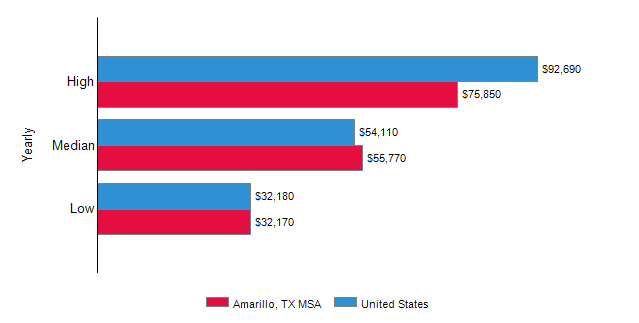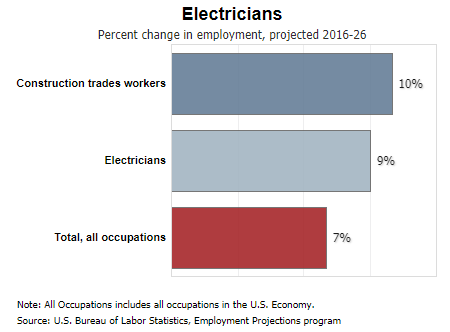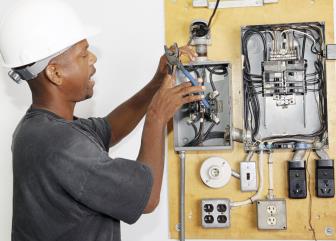Electrician
| Quick Facts: Electricians | |
| (Amarillo MSA) 2017 Median Pay | $55,770 per year |
| $26.81 per hour | |
| Typical Entry-Level Education | High school diploma or equivalent |
| Work Experience in a Related Occupation | None |
| On-the-job Training | Apprenticeship |
| (US) Number of Jobs, 2016 | 666,900 |
| (US) Job Outlook, 2016-26 | 9% (As fast as average) |
| (US) Employment Change, 2016-26 | 59,600 |

What Electricians Do
Electricians install, maintain, and repair electrical power, communications, lighting, and control systems in homes, businesses, and factories.
Work Environment
Electricians work indoors and outdoors in nearly every type of facility. Almost all electricians work full time, which may include evenings and weekends. Potential on-the-job injuries include electrical shocks and burns, cuts, and falls.
How to Become an Electrician
Most electricians learn through an apprenticeship, but some start out by attending a technical school. Most states require electricians to be licensed.
Pay
The median annual wage for electricians was $54,110 in May 2017.
Job Outlook
Employment of electricians is projected to grow 9 percent from 2016 to 2026, about as fast as the average for all occupations. As homes and businesses require more wiring, electricians will be needed to install the necessary components.

Duties
Electricians typically do the following:
- Read blueprints or technical diagrams
- Install and maintain wiring, control, and lighting systems
- Inspect electrical components, such as transformers and circuit breakers
- Identify electrical problems using a variety of testing devices
- Repair or replace wiring, equipment, or fixtures using hand tools and power tools
- Follow state and local building regulations based on the National Electrical Code
- Direct and train workers to install, maintain, or repair electrical wiring or equipment
Almost every building has an electrical power, communications, lighting, and control system that is installed during construction and maintained after that. These systems power the lights, appliances, and equipment that make people’s lives and jobs easier and more comfortable.
Installing electrical systems in newly constructed buildings is often less complicated than maintaining equipment in existing buildings because electrical wiring is more easily accessible during construction. Maintaining equipment and systems involves identifying problems and repairing broken equipment that is sometimes difficult to reach. Maintenance work may include fixing or replacing parts, light fixtures, control systems, motors, and other types of electrical equipment.
Electricians read blueprints, which include technical diagrams of electrical systems that show the location of circuits, outlets, and other equipment. They use different types of hand and power tools, such as conduit benders, to run and protect wiring. Other commonly used hand and power tools include screwdrivers, wire strippers, drills, and saws. While troubleshooting, electricians also may use ammeters, voltmeters, thermal scanners, and cable testers to find problems and ensure that components are working properly.
Many electricians work alone, but sometimes they collaborate with others. For example, experienced electricians may work with building engineers and architects to help design electrical systems for new construction. Some electricians may also consult with other construction specialists, such as elevator installers and heating and air conditioning workers, to help install or maintain electrical or power systems. At larger companies, electricians are more likely to work as part of a crew; they may direct helpers and apprentices to complete jobs.
Although lineman electricians install distribution and transmission lines to deliver electricity from its source to customers, they are covered in the line installers and repairers profile.
Electricians held about 666,900 jobs in 2016. The largest employers of electricians were as follows:
| Electrical contractors and other wiring installation contractors | 65% |
| Self-employed workers | 8 |
| Manufacturing | 8 |
| Government | 4 |
| Employment services | 2 |
Electricians work indoors and outdoors, at homes, businesses, factories, and construction sites. Because electricians must travel to different worksites, local or long-distance commuting is often required.
On the jobsite, they occasionally work in cramped spaces. The long periods of standing and kneeling can be tiring. Those who work in factories are often subject to noisy machinery. As a result, hearing protection must be worn to protect workers from excess noise.
Many electricians work alone, but sometimes they collaborate with others. At larger companies, electricians are more likely to work as part of a crew, directing helpers and apprentices to complete jobs.
Injuries and Illnesses
Electricians have a higher rate of injuries and illnesses than the national average. Although a few accidents are potentially fatal, common injuries include electrical shocks, falls, burns, and other minor injuries. Workers must therefore wear protective clothing and safety glasses to reduce these risks.
Work Schedules
Almost all electricians worked full time in 2016. Work schedules may include evenings and weekends, and may vary during times of inclement weather. During scheduled maintenance, or on construction sites, electricians can expect to work overtime.
Self-employed electricians often work in residential construction and may have the ability to set their own schedule.

Most electricians learn through an apprenticeship, but some start out by attending a technical school. Most states require electricians to be licensed. For more information, contact your local or state electrical licensing board.
Education
A high school diploma or equivalent is required to become an electrician.
Some electricians start out by attending a technical school. Many technical schools offer programs related to circuitry, safety practices, and basic electrical information. Graduates usually receive credit toward their apprenticeship.
Training
Most electricians learn their trade in a 4- or 5-year apprenticeship program. For each year of the program, apprentices typically receive 2,000 hours of paid on-the-job training as well as some classroom instruction.
In the classroom, apprentices learn electrical theory, blueprint reading, mathematics, electrical code requirements, and safety and first-aid practices. They may also receive specialized training related to soldering, communications, fire alarm systems, and elevators.
Several groups, including unions and contractor associations, sponsor apprenticeship programs. Apprenticeship requirements vary by state and locality.
Some electrical contractors have their own training programs, which are not recognized apprenticeship programs but include both classroom and on-the-job training. Although most workers enter apprenticeships directly, some electricians enter apprenticeship programs after working as a helper. The Home Builders Institute offers a preapprenticeship certificate training (PACT) program for eight construction trades, including electricians.
After completing an apprenticeship program, electricians are considered to be journey workers and may perform duties on their own, subject to any local or state licensing requirements.
Licenses, Certifications, and Registrations
Most states require electricians to pass a test and be licensed. Requirements vary by state. For more information, contact your local or state electrical licensing board. Many of the requirements can be found on the National Electrical Contractors Association’s website.
The tests have questions related to the National Electrical Code and state and local electrical codes, all of which set standards for the safe installation of electrical wiring and equipment.
Electricians may be required to take continuing education courses in order to maintain their licenses. These courses are usually related to safety practices, changes to the electrical code, and training from manufacturers in specific products.
Important Qualities
Color vision. Electricians must identify electrical wires by color.
Communication skills. Electricians work with people on a regular basis. They should be friendly and be able to address customers’ questions.
Critical-thinking skills. Electricians perform tests and use the results to diagnose problems. For example, when an outlet is not working, they may use a multimeter to check the voltage, amperage, or resistance in order to determine the best course of action.
Physical stamina. Electricians often need to move around all day while running wire and connecting fixtures to the wire.
Physical strength. Electricians need to be strong enough to move heavy components, which may weigh up to 50 pounds.
Troubleshooting skills. Electricians find, diagnose, and repair problems. For example, if a motor stops working, they perform tests to determine the cause of its failure and then, depending on the results, fix or replace the motor.
The median annual wage for electricians was $55,770 (Amarillo MSA) in May 2017. The median wage is the wage at which half the workers in an occupation earned more than that amount and half earned less. The lowest 10 percent earned less than $32,170, and the highest 10 percent earned more than $75,850.
In May 2017, the median annual wages for electricians in the top industries in which they worked were as follows:
| Government | $60,570 |
| Manufacturing | $58,470 |
| Electrical contractors and other wiring installation contractors | $52,190 |
| Employment services | $47,520 |
Apprentices receive less pay than fully trained electricians, but their pay increases as they learn to do more.
Almost all electricians worked full time in 2016. Work schedules may include evenings and weekends, and may vary during times of inclement weather. During scheduled maintenance, or on construction sites, electricians can expect to work overtime.
Self-employed electricians often work in residential construction and may have the ability to set their own schedule.
Union Membership
Compared with workers in all occupations, electricians had a higher percentage of workers who belonged to a union in 2016. Although there is no single union that covers all electricians, the largest organizer of these workers is the International Brotherhood of Electrical Workers.

Employment of electricians is projected to grow 9 percent from 2016 to 2026, about as fast as the average for all occupations. Increases in construction spending and growing demand for alternative energy sources will drive demand for electricians.
Alternative power generation, such as solar and wind, is an emerging field that should require more electricians for installation. Increasingly, electricians will be needed to link these alternative power sources to homes and power grids over the coming decade. Employment growth stemming from these sources, however, will largely be dependent on government policy.
Job Prospects
Electricians who can perform many different tasks, such as electronic systems repair, solar photovoltaic installation, and industrial component wiring, should have the best job opportunities.
Employment of electricians fluctuates with the overall economy. On the one hand, there is greater demand for electricians during peak periods of building construction and maintenance. On the other hand, workers may experience periods of unemployment when the overall level of construction and maintenance falls.
Area Universities/Colleges/Training Providers
Bureau of Labor Statistics, U.S. Department of Labor, Occupational Outlook Handbook, Electricians, on the Internet at https://www.bls.gov/ooh/construction-and-extraction/electricians.htm (visited September 19, 2018).
Salary information comes from the Bureau of Labor Statistics, Occupational Employment Statistics Program, a semi-annual survey that provides wage and employment statistics for the nation, each state, and sub-state regions.
Tagged as Apprentice, Apprenticeship, Construction, Construction and Extraction Occupations, Electrical, Electrical Training Alliance, Electrician, Electrician Apprentice, IBEW 602, IEC, Independent Electrical Contractors, JATC, Marcus Lundegreen, NECA, West Texas JATC.
Written by Phillip













